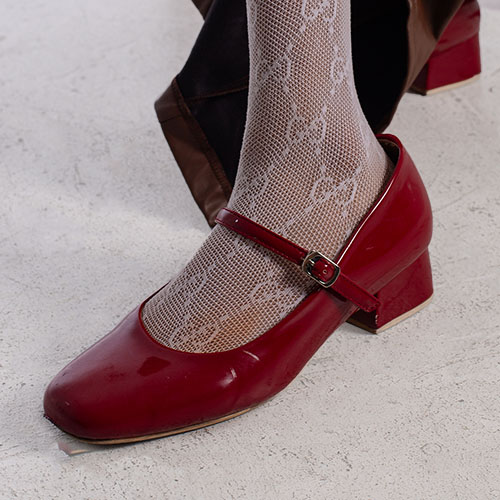Recommend ko 'yan!
Mary Janes
The term “Mary Jane” originated from the Buster Brown comic strip created by R.F. Outcault. The character Mary Jane wore this distinctive shoe style, leading to its association with her name. Traditionally, Mary Janes are characterized by a closed, low-cut design with one or more straps across the instep. They were initially made of black leather and became popular as children’s footwear due to their practicality and ease of wear. During the 1920s-1930s, Mary Janes transitioned into women’s fashion, especially during the flapper era, where they complemented shorter hemlines and dance-friendly attire. The shoes maintained popularity among school-aged girls and were often part of school uniforms, symbolizing innocence and youth in the Mid-20th Century.
Mary Janes have seen a significant comeback in the 2020s, with designers reimagining them in various styles. Brands like Prada, Miu Miu, and Wales Bonner have featured Mary Janes in their collections, showcasing them in patent leathers, bold colors, and platform soles. The fusion of Mary Janes with sneakers has emerged, offering comfort without sacrificing style. Retailers like Walmart and Penneys have made Mary Janes accessible to a broader audience, offering trendy designs at budget-friendly prices.


Mary Janes
The term “Mary Jane” originated from the Buster Brown comic strip created by R.F. Outcault. The character Mary Jane wore this distinctive shoe style, leading to its association with her name. Traditionally, Mary Janes are characterized by a closed, low-cut design with one or more straps across the instep. They were initially made of black leather and became popular as children’s footwear due to their practicality and ease of wear. During the 1920s-1930s, Mary Janes transitioned into women’s fashion, especially during the flapper era, where they complemented shorter hemlines and dance-friendly attire. The shoes maintained popularity among school-aged girls and were often part of school uniforms, symbolizing innocence and youth in the Mid-20th Century.
Mary Janes have seen a significant comeback in the 2020s, with designers reimagining them in various styles. Brands like Prada, Miu Miu, and Wales Bonner have featured Mary Janes in their collections, showcasing them in patent leathers, bold colors, and platform soles. The fusion of Mary Janes with sneakers has emerged, offering comfort without sacrificing style. Retailers like Walmart and Penneys have made Mary Janes accessible to a broader audience, offering trendy designs at budget-friendly prices.


Recommend ko 'yan!
Mary Janes
The term “Mary Jane” originated from the Buster Brown comic strip created by R.F. Outcault. The character Mary Jane wore this distinctive shoe style, leading to its association with her name. Traditionally, Mary Janes are characterized by a closed, low-cut design with one or more straps across the instep. They were initially made of black leather and became popular as children’s footwear due to their practicality and ease of wear. During the 1920s-1930s, Mary Janes transitioned into women’s fashion, especially during the flapper era, where they complemented shorter hemlines and dance-friendly attire. The shoes maintained popularity among school-aged girls and were often part of school uniforms, symbolizing innocence and youth in the Mid-20th Century.
Mary Janes have seen a significant comeback in the 2020s, with designers reimagining them in various styles. Brands like Prada, Miu Miu, and Wales Bonner have featured Mary Janes in their collections, showcasing them in patent leathers, bold colors, and platform soles. The fusion of Mary Janes with sneakers has emerged, offering comfort without sacrificing style. Retailers like Walmart and Penneys have made Mary Janes accessible to a broader audience, offering trendy designs at budget-friendly prices.

